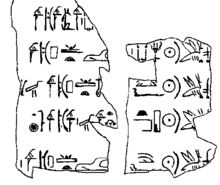Sihathor
| Sihathor | ||||||||||||||||||||||||||||||||||||||||
|---|---|---|---|---|---|---|---|---|---|---|---|---|---|---|---|---|---|---|---|---|---|---|---|---|---|---|---|---|---|---|---|---|---|---|---|---|---|---|---|---|
| Sahathor, Menuazra[1] | ||||||||||||||||||||||||||||||||||||||||
 Sihathor's name on the Turin canon (second row from bottom) | ||||||||||||||||||||||||||||||||||||||||
| Pharaoh | ||||||||||||||||||||||||||||||||||||||||
| Reign | less than a year, "[...] months and 3 days" as a coregent with Neferhotep I[1] | |||||||||||||||||||||||||||||||||||||||
| Coregency | Neferhotep I | |||||||||||||||||||||||||||||||||||||||
| Predecessor | Neferhotep I | |||||||||||||||||||||||||||||||||||||||
| Successor | Sobekhotep IV | |||||||||||||||||||||||||||||||||||||||
| ||||||||||||||||||||||||||||||||||||||||
| Father | Haankhef | |||||||||||||||||||||||||||||||||||||||
| Mother | Kemi | |||||||||||||||||||||||||||||||||||||||
| Burial | likely intended to be in Abydos close to those of his brothers | |||||||||||||||||||||||||||||||||||||||
| Dynasty | 13th dynasty | |||||||||||||||||||||||||||||||||||||||
Menwadjre Sihathor was an ephemeral ruler of the
According to Egyptologist Kim Ryholt, Sihathor died in 1733 BC[2] while Detlef Franke dates his short reign to 1694 BC.[3] His tomb is likely to be the unfinished one located between the tombs of his brothers S9 and S10, in Abydos.
Attestations
According to the latest reading of the Turin canon by Ryholt, Sihathor is recorded there on column 7, line 26 (Gardiner col. 6, line 26).[2] Sihathor is attested on two statues from the
Family

The family of Sihathor is known thanks to the rock inscriptions of Philae and Sehel made by his brother Neferhotep I. Sihathor's father is thus known to be Haankhef, his mother was Kemi and his brothers were Neferhotep I and Sobekhotep IV, the later of whom eventually succeeded him on the throne.[2]
Tomb
The Egyptologist and archaeologist
These attributions are crucial for locating Sihathor's tomb, as indeed Wegner has found an unfinished royal burial at the immediate north-east of S10, east of S9. According to him, its position suggest very strongly that it was intended for Neferhotep's chosen heir Sihathor. The burial seems to have been abandoned at the death of its intended owner, its massive granite sarcophagus reused at a later time, during the chaotic Second Intermediate Period.[9]
References
- ^ ISBN 978-1-905299-37-9, 2008, p. 430
- ^ a b c d e f g K.S.B. Ryholt, The Political Situation in Egypt during the Second Intermediate Period, c.1800–1550 BC, Carsten Niebuhr Institute Publications, vol. 20. Copenhagen: Museum Tusculanum Press, 1997, excerpts available online here
- ISBN 978-90-04-11385-5, pp. 168–196.
- ^ Picture of the cylinder seal
- ISBN 3-8053-2526-6
- ^ Flinders Petrie: Scarabs and cylinders with names (1917), available copyright-free here, pl. XVIII
- S2CID 163519900.
- .
- University of Chicago Oriental Institute. On Youtube The Pharaohs of Anubis-Mountain, 28 October 2015.
